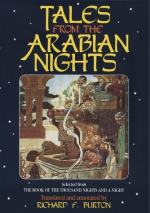[FN#82] i.e. Fortune so willed it (euphemistically).
[FN#83] The “minaret” being feminine is usually compared with a fair young girl. The oldest minaret proper is supposed to have been built in Damascus by the Ommiade Caliph (No. X.) Al-Walid A.H. 86-96 (=705-715). According to Ainsworth (ii. 113) the second was at Kuch Hisar in Chaldea.
[FN#84] None of the pure Badawi can swim for the best of reasons, want of waters.
[FN#85] The baser sort of Badawi is never to be trusted: he is a traitor born, and looks upon fair play as folly or cowardice. Neither oath nor kindness can bind him: he unites the cruelty of the cat with the wildness of the wolf. How many Englishmen have lost their lives by not knowing these elementary truths! The race has not changed from the days of Mandeville (A.D. 1322) whose “Arabians, who are called Bedouins and Ascopards (?), are right felonious and foul, and of a cursed nature.” In his day they “carried but one shield and one spear, without other arm :” now, unhappily for travellers, they have matchlocks and most tribes can manufacture a something called by courtesy gunpowder.
[FN#86] Thus by Arab custom they become friends.
[FN#87] Our classical term for a noble Arab horse.
[FN#88] In Arab. “Khayl” is=horse; Husan, a stallion; Hudud, a brood stallion; Faras, a mare (but sometimes used as a horse and meaning “that tears over the ground"), Jiyad a steed (noble); Kadish, a nag (ignoble); Mohr a colt and Mohrah, a filly. There are dozens of other names but these suffice for conversation
[FN#89] Al-Katul, the slayer; Al-Majnun, the mad; both high compliments in the style inverted.
[FN#90] This was a highly honourable exploit, which would bring the doer fame as well as gain.
[FN#91] This is a true and life-like description of horse-stealing in the Desert: Antar and Burckhardt will confirm every word. A noble Arab stallion is supposed to fight for his rider and to wake him at night if he see any sign of danger. The owner generally sleeps under the belly of the beast which keeps eyes and ears alert till dawn.
[FN#92] Arab. “Yaum al tanadi,” i.e. Resurrection-day.




